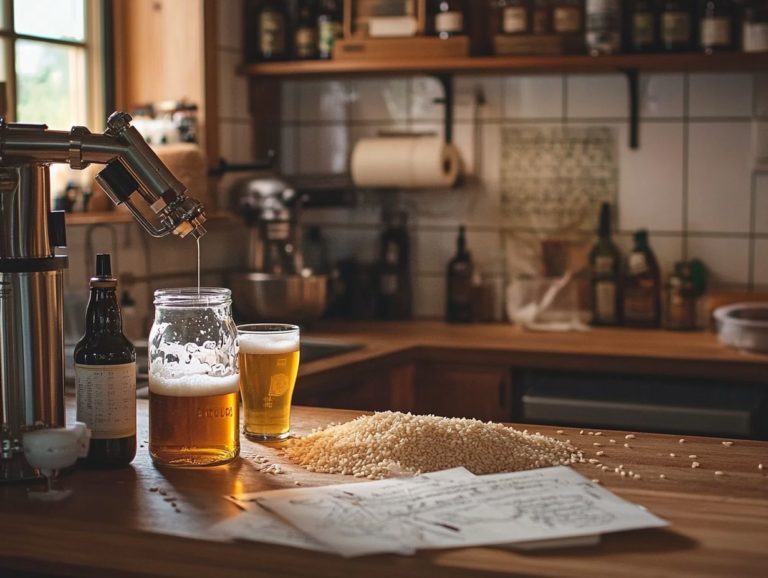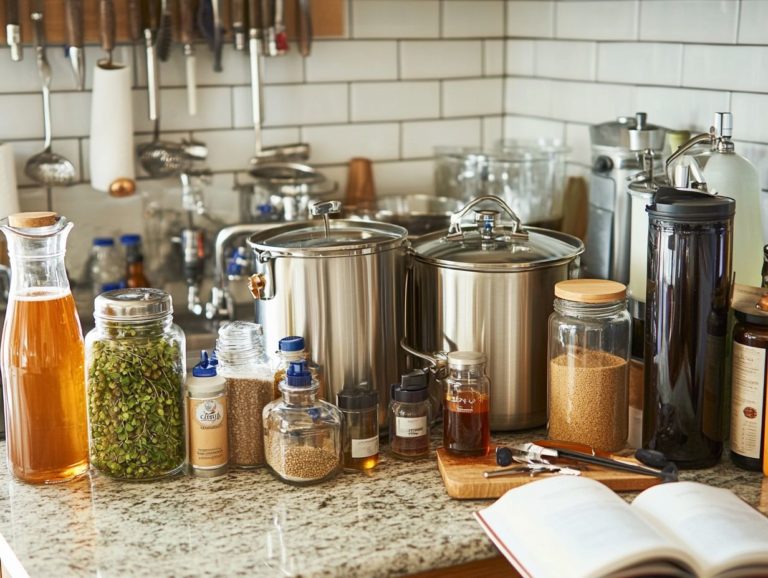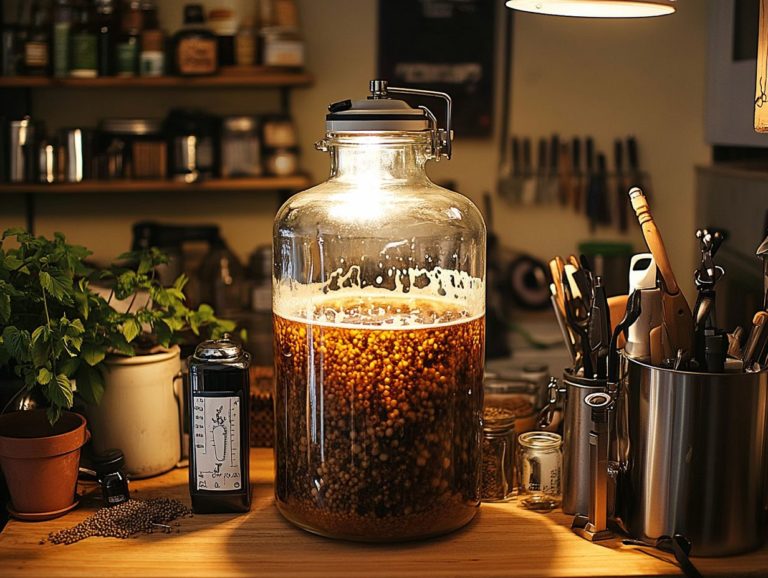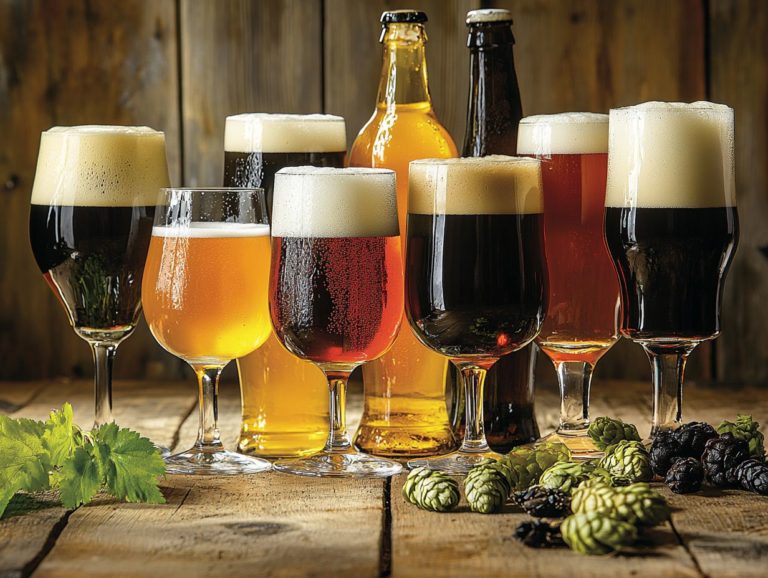5 Essential Tools Every Home Brewer Needs
Contents
Essential Homebrewing Equipment
Home brewing transcends the boundaries of mere hobby; it transforms into a creative journey, empowering you to craft unique flavors and styles that reflect your personal taste in homebrew.
Whether you re a seasoned brewer or just dipping your toes into the craft, possessing the right tools and equipment can significantly elevate your brewing experience.
In this exploration, you ll discover five essential pieces of homebrewing equipment that every home brewer should consider, ranging from high-quality brewing kettles to precise thermometers.
We ll delve into the various types of home brewing gear, highlight common pitfalls to avoid, and provide invaluable tips for upgrading your setup with the best quality homebrewing equipment.
Join us now as we uncover the essential tools that will elevate your brewing experience!
Key Takeaways:
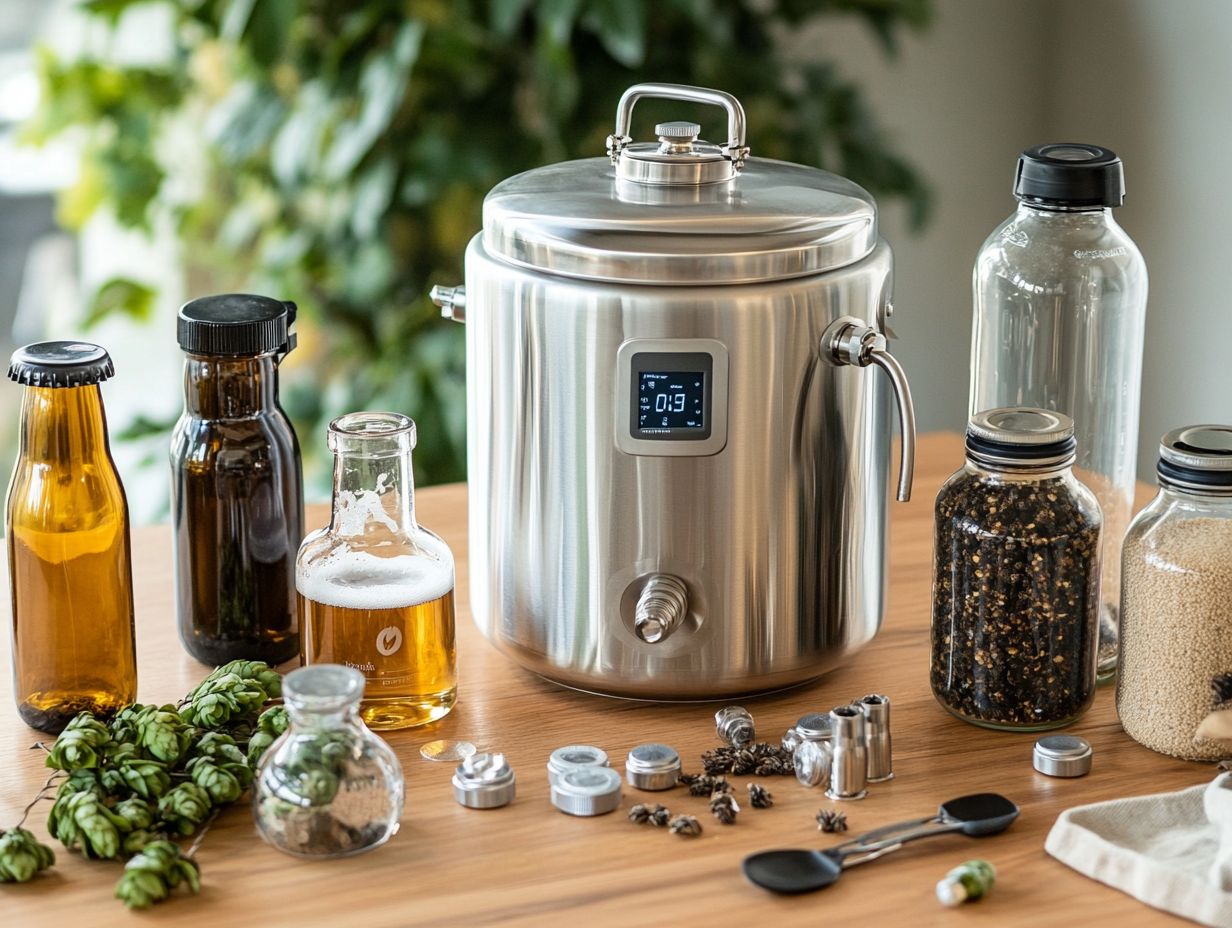
- Invest in a quality brewing kettle to enhance the brewing process!
- Use an accurate thermometer to maintain perfect brewing temperatures!
- Employ a hydrometer to track fermentation accurately!
1. Quality Brewing Kettle
A quality brewing kettle is the cornerstone of your homebrewing journey, ensuring that the heating process during your beer brewing is both efficient and effective. This essential piece of equipment can significantly influence the quality of your brew, allowing for precise temperature control crucial for achieving that perfect flavor profile and fermentation process.
Investing in a high-quality kettle greatly enhances your brewing experience and leads to the creation of exceptional homebrew. Brands like Br u Supply, championed by beer expert Joe Postma, are renowned for their durable and temperature-efficient brewing kettles.
The material of your kettle, such as aluminum versus stainless steel, plays a vital role in performance. Stainless steel, in particular, offers superior heat retention and resistance to corrosion, making it a wise choice for serious brewers.
If you re aiming for the best results, temperature control becomes paramount; even the slightest deviation can dramatically alter your brew’s characteristics.
A quality kettle should come equipped with options for integrating tools like thermometers and hydrometers, allowing you to monitor both temperature and specific gravity throughout the brewing process.
By utilizing these tools, you not only enhance your precision but also enable yourself to make data-driven adjustments, ensuring the final product truly reflects your desired taste and quality.
2. Accurate Thermometer for Homebrew
An accurate thermometer is an essential tool for any homebrewer, playing a pivotal role in maintaining the proper temperature throughout the brewing process, which directly impacts the quality of your beer.
You have various thermometer options at your disposal, including digital, dial, and infrared models, each offering unique features tailored for different stages of brewing.
Digital thermometers deliver quick readings and often come with a probe for easy insertion into liquids, making them perfect for monitoring the warm liquid extracted from malted grains (wort) temperature during boiling.
Dial thermometers may be a bit slower, but they add a classic touch and can be directly installed on your brewing equipment. If you prefer a non-contact approach, infrared thermometers are great for measuring the temperature of heated surfaces without any fuss, ensuring your brewing process remains efficient.
To ensure accuracy, it s crucial to calibrate your thermometers regularly, following the manufacturer s instructions. Position them strategically at critical measurement points, such as near the boiling kettle or fermentation vessel, to achieve the best results in your brewing journey and improve the quality of your homebrew.
3. Hydrometer
A hydrometer is an essential tool in your homebrewing arsenal. It helps you measure the density of the liquid accurately, which indicates how much sugar is in the liquid.
This measurement helps you track fermentation progress. It also allows you to estimate your beer’s alcohol content.
This instrument offers invaluable insights into the conversion of sugars into alcohol, which is fundamental for crafting a well-balanced brew. To truly harness its power, take readings at various stages: the initial gravity before fermentation, midway through the process, and the final gravity once fermentation is complete.
By meticulously interpreting these measurements, you can determine the alcohol level and evaluate the overall health of your fermentation. Ensuring that the gravity levels meet your expectations allows you to identify potential issues early on, giving you the opportunity to make adjustments that enhance your final product.
4. Auto-Siphon
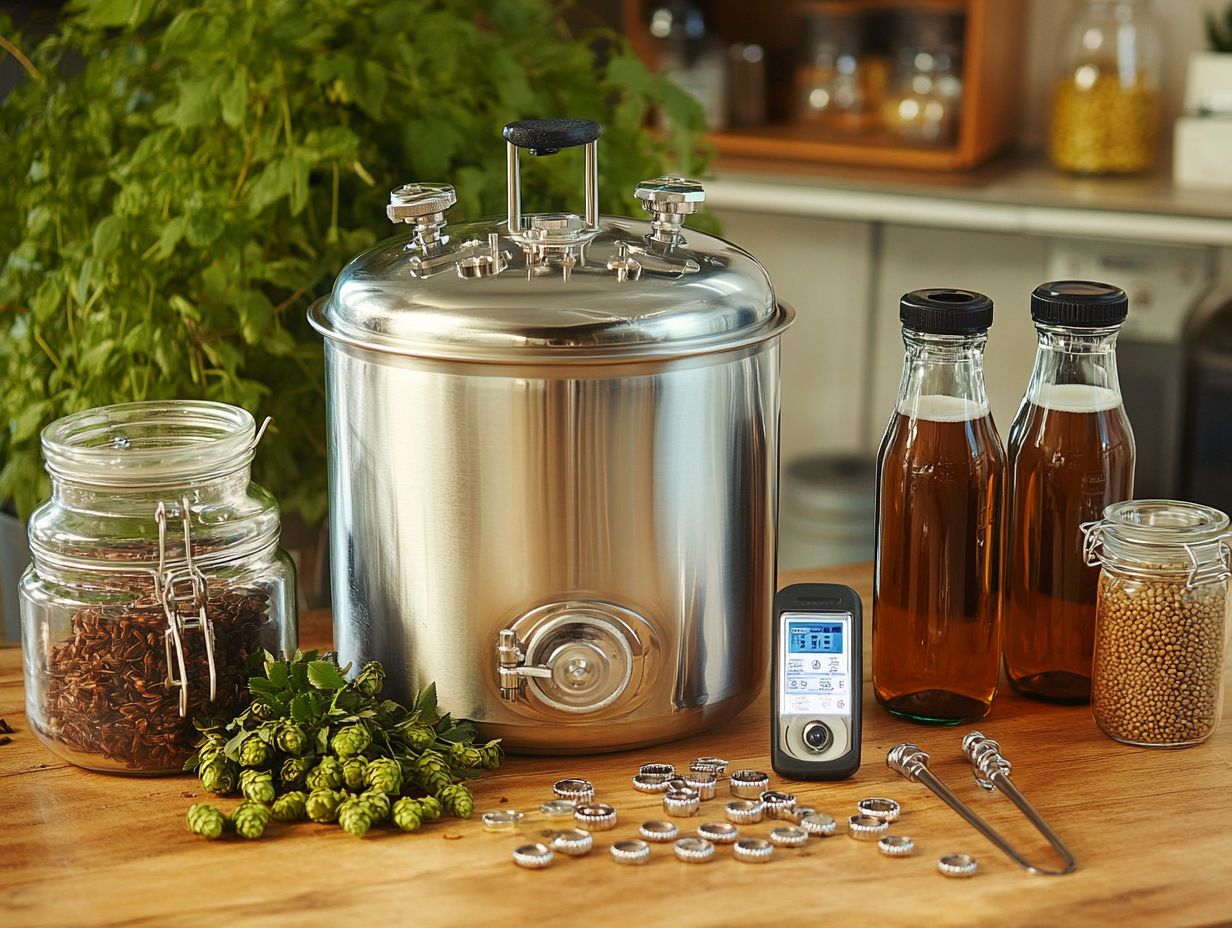
An auto-siphon is a vital tool in your homebrewing arsenal. It streamlines the transfer of beer from one vessel to another while minimizing the risk of contamination.
This handy device upholds the cleanliness essential for crafting quality beer, and its simple pumping mechanism provides a controlled flow.
This significantly reduces the chances of oxidation that traditional racking canes often cause. The auto-siphon enhances your efficiency during the bottling process, allowing you to fill bottles quickly and cleanly without disturbing the sediment settled at the bottom of the fermenter.
To ensure your auto-siphon performs at its best and to prevent off-flavors from creeping into your brew, it s crucial to clean and sanitize it thoroughly after each use. A solution of hot water paired with a no-rinse sanitizer works beautifully, and using a brush can help eliminate stubborn residues.
5. Fermentation Vessel
The fermentation vessel, whether it s a fermentation bucket or a carboy, plays a pivotal role in your brewing journey. It houses the wort during the critical fermentation process.
This vessel creates a controlled environment for yeast to thrive, ensuring that the magical transformation of wort into beer unfolds seamlessly.
You ll find a variety of fermentation vessels available, each catering to distinct brewing styles and personal preferences. For example, plastic fermentation buckets are lightweight and budget-friendly, making them a favorite among newcomers.
Glass carboys, on the other hand, provide a non-reactive surface that helps maintain a pure flavor profile, perfect for those more seasoned in their craft. Your choice of vessel also affects cleanliness and ease of monitoring the fermentation process.
It’s crucial to uphold strict sanitation practices because even the slightest contamination can jeopardize your entire batch. You can easily monitor the fermentation process by keeping an eye on the airlock, which allows gas to escape while safeguarding against unwanted intrusions.
Not only does it manage pressure within the vessel, but it also acts as a protective barrier for your brew, making it a must-have in any brewer s collection.
What Is Home Brewing and Why Is It Gaining Popularity?
Home brewing is your gateway to the art and science of crafting beer right in your own kitchen. By utilizing a variety of ingredients and equipment, such as kettles, fermenters, and cappers, you can create unique flavors and styles that cater specifically to your palate. This fun hobby encourages you to try out different recipes and fermentation methods, offering a personalized brewing experience that is as fulfilling as it is rewarding.
With the growing availability of brewing kits from suppliers like Br u Supply and invaluable insights from experts such as Joe Postma, you are enabled to embark on your brewing adventures with confidence and creativity. These kits often include essential tools and ingredients for brewing your first batch successfully.
The excitement of crafting a brew that truly reflects your taste and preferences is a significant allure. You ll find yourself drawn to the joy of experimenting with an array of ingredients, from hops to specialty grains, each capable of yielding unexpected and delightful results. Trying out various recipes and fermentation methods offers a unique brewing experience.
The camaraderie found within local home brewing communities only enhances your journey; sharing tips, hosting tasting sessions, and exchanging feedback creates a supportive atmosphere that nurtures your passion for brewing quality beer. Join a local community today. Sharing tips and hosting tasting sessions can supercharge your brewing journey!
As more resources become available think online forums and instructional videos the path to brewing your own unique beers becomes increasingly accessible, inviting you to join the ranks of seasoned enthusiasts and embark on a flavorful adventure. Furthermore, you’ll find specific advice on tools like hydrometers, fermentation buckets, and bottling techniques to refine your brewing process.
What Are the Different Types of Home Brewing Equipment?
Home brewing equipment includes a range of essential tools and vessels vital to your brewing journey, featuring items such as brewing kettles, fermentation vessels, bottles and cappers, and specialized brewing kits tailored to all skill levels. Specialized brewing kits may include pre-measured ingredients and detailed instructions, making it easier for beginners to get started.
Each category of equipment plays a distinct role, from heating your ingredients to facilitating fermentation and carbonation. For example, you might opt for stainless steel brewing kettles, renowned for their durability and excellent heat retention, while aluminum kettles, though lighter, could lead to uneven heating. Proper cleaning and sanitizing of equipment, such as using a no-rinse sanitizer, is crucial to avoid contamination and ensure a successful batch of homebrew.
Fermentation vessels, which can vary from glass carboys to plastic buckets, are essential in the brewing process, providing a controlled environment for yeast to work its magic. By investing in reliable tools, such as the essential gear for home brewing techniques, you not only elevate your brewing experience but also enhance the consistency and quality of your final product, turning each batch into a gratifying achievement for any home brewer.
How Can These Tools Improve the Brewing Process?
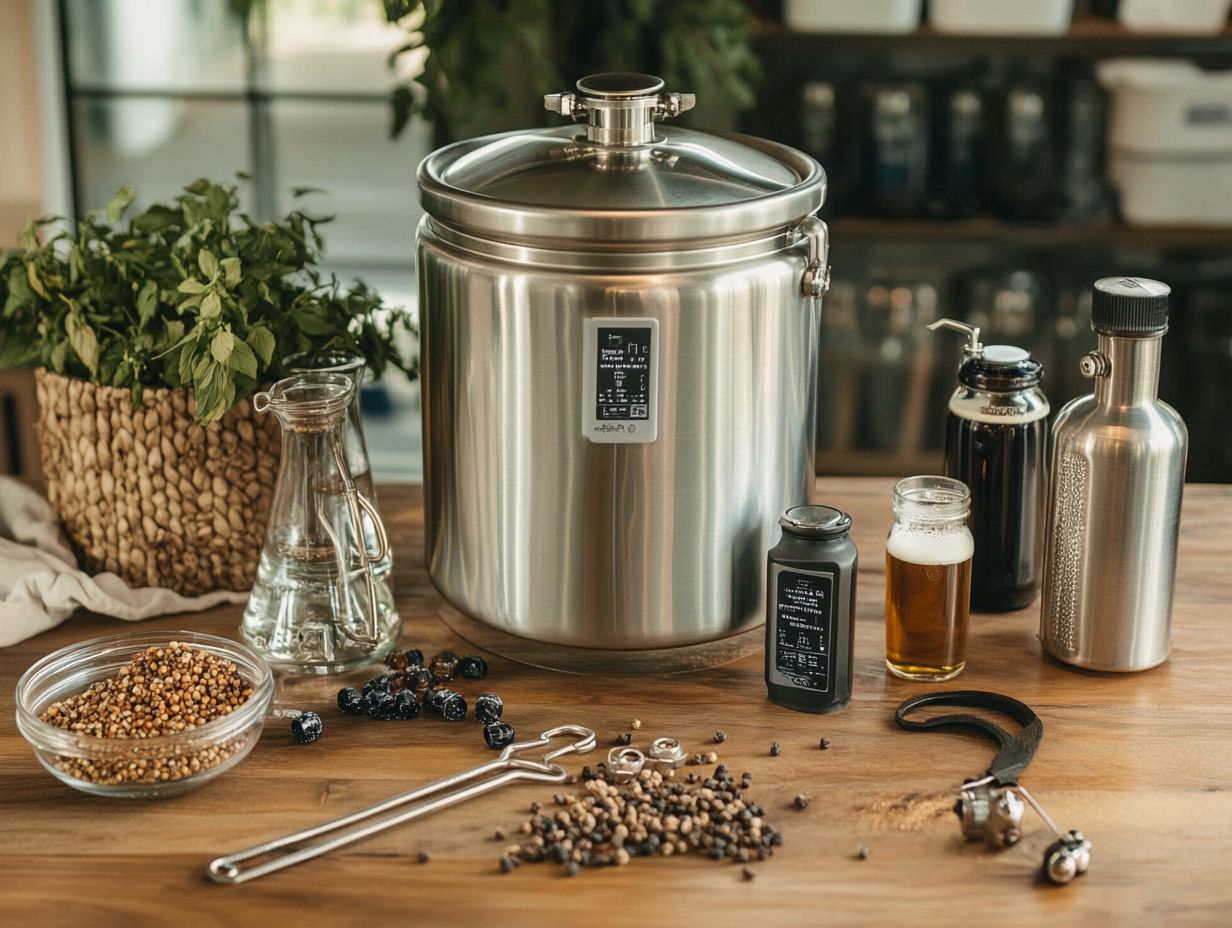
Harnessing the right tools during your brewing process can dramatically elevate both the quality and efficiency of your homebrew. This approach allows you to achieve superior temperature control, accurate measurements, and streamlined workflows.
Consider thermometers, for instance; they are essential for monitoring your brewing temperature. Any fluctuations can lead to undesirable flavors or incomplete fermentation. By keeping within the ideal heating range, you can ensure a more consistent and enjoyable brew, which is critical for achieving the desired flavors. Additionally, having the 5 essential tools for home brewing success can further enhance your brewing experience.
Hydrometers are equally essential. They enable you to measure specific gravity, which is vital for determining sugar content and, ultimately, the potential alcohol level. This insight helps you sidestep common pitfalls like over or under-fermentation.
Using auto-siphons also transforms your brewing experience, allowing for a smoother transfer of liquid while minimizing exposure to oxygen. This significantly reduces the risk of oxidation.
When these tools work in harmony, they create a comprehensive system that not only supports quality assurance and consistency but also elevates your entire homebrewing journey with the right essential accessories for home brewing.
What Are the Common Mistakes to Avoid When Using These Tools?
As a new homebrewer, you may find yourself stumbling into some common pitfalls while using brewing tools, which can harm the quality of your beer. Issues like inadequate sanitation and improper temperature control can all come into play.
These missteps can lead to off-flavors, unwanted contaminants, and inconsistent results, ultimately tarnishing your brew. One of the most crucial elements of brewing is maintaining a clean environment. Neglecting to properly sanitize your tools can introduce harmful bacteria into your mixture. Temperature fluctuations during fermentation can disrupt yeast activity and cause poor fermentation outcomes.
To steer clear of these issues, it’s essential for you to establish a rigorous cleanliness routine, calibrate your measuring devices regularly, and meticulously track your brewing temperatures. By embracing these best practices and utilizing essential brewing tools for craft beer enthusiasts, you can significantly elevate your brewing experience and craft high-quality beer that you can truly enjoy.
How Can a Home Brewer Upgrade Their Equipment?
Upgrading your home brewing equipment is an exciting step you can take now to elevate your brewing experience and enhance the quality of your beer. You have a variety of options at your disposal, from advanced fermentation vessels to high-efficiency brewing kettles.
By moving away from traditional plastic fermentation vessels and embracing glass alternatives, you can significantly minimize the risk of contamination while gaining better visibility into your brew’s clarity. Investing in precise temperature control tools is essential to ensure that every fermentation phase unfolds under optimal conditions key to developing robust flavors. To enhance your home brewing experience further, consider checking out these must-have books on home brewing equipment.
Acquiring additional brewing equipment, such as a reliable capper and effective sanitizer systems, streamlines your brewing process and enhances hygiene. These thoughtful upgrades lead to superior fermentation results and enrich your overall brewing satisfaction, transforming your journey from novice to expert into an enjoyable and rewarding adventure.
What Are the Essential Ingredients for Home Brewing?
The essential ingredients for home brewing include key components such as hops, yeast, water, and malted grains, all of which contribute to the distinct flavors and characteristics of your final beer.
Each ingredient plays a pivotal role in your brewing process. It all starts with the malted grains, which provide the fermentable sugars that yeast eagerly converts into alcohol and carbon dioxide. Yeast doesn t just ferment those sugars; it also adds unique flavors and aromas through its various strains, significantly influencing your beer’s overall taste profile.
Hops introduce a delightful bitterness that balances the sweetness of the malt while adding floral or fruity notes, depending on the variety you choose. And let s not forget water often the unsung hero of brewing. It affects every facet of the process, from flavor extraction to the final mouthfeel of your beer.
Sourcing these ingredients from reputable suppliers is crucial for ensuring quality. Any variance in ingredients can dramatically alter fermentation outcomes and impact your overall enjoyment of the beer you craft at home.
Frequently Asked Questions
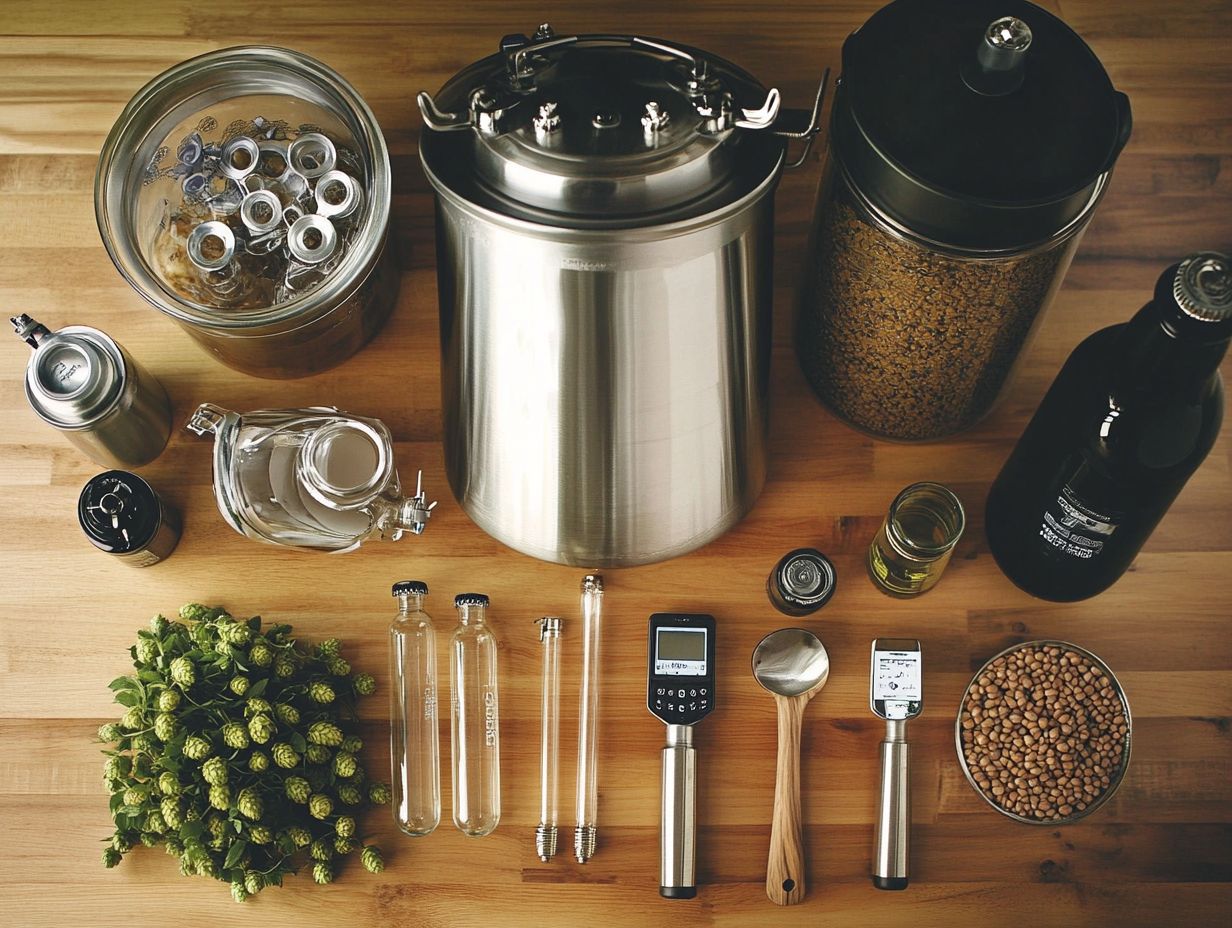
What are the 5 essential tools every home brewer needs?
- Thermometer
- Hydrometer
- Fermenter
- Bottling equipment
- Brewing kettle
Why is a thermometer necessary for home brewing?
A thermometer is necessary for home brewing because it helps to monitor the temperature of the brew during the mashing and fermentation processes. This is crucial for achieving the desired flavor and alcohol content.
What is the purpose of a hydrometer in home brewing?
A hydrometer is used to measure the specific gravity of the brew, which indicates the amount of fermentable sugars present. This measurement is important for calculating the alcohol content of the finished product.
Do I need a fermenter for home brewing?
Yes, a fermenter is an essential tool for home brewing. It is where the fermentation process takes place and allows for proper control of temperature and exposure to oxygen to achieve the desired flavor in the beer.
What Bottling Equipment Do You Need for Home Brewing?
Ready to bottle your brew? Essential bottling equipment includes a siphon, bottle filler, bottle capper, and bottles. These tools help transfer beer from the fermenter into bottles and seal them for carbonation.
Choosing the Right Brewing Kettle for Home Brewing
You can use any pot or kettle for home brewing. However, it’s best to use one designed for brewing, as they often come with helpful features like a built-in thermometer and spigot for easy wort transfer.
Don’t wait to enjoy your home brew!

